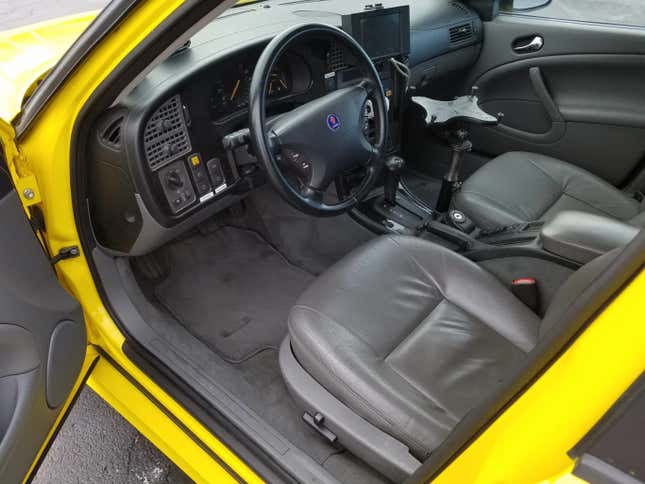Saabs are weird, funky cars that are most frequently revered by nerds, be they car nerds or college professors, and this particular Saab might be the nerdiest car you can buy right now. It was modified by Scandanavian Airport and Road Systems (SARSYS-ASFT) and sent to Salt Lake City International Airport for duty testing runway friction levels to ensure safe levels of grip for landing planes, and it’s freakin’ badass. It’s currently being auctioned on Bring A Trailer, with just one day left, so get your checkbooks out now.
This 2004 Saab 9-5 wagon is almost certainly a safer buy than the nightmare 9-3 I used to own, as it has just 29,000 miles and lived a relatively simple life running runway friction tests for 20 years. In order to be ready for duty, SARSYS retrofitted it with a roof-mounted light bar, a giant water tank in place of the rear seats, an underbody-mounted electronically retractable airplane-style wheel, a central touchscreen control unit, and a printer for test results. If you haven’t noticed yet, it’s also painted bright yellow. It’s an Arc trim wagon, which means it ain’t very fancy inside, though it has power adjustable and heated leather seats, a five-speed automatic transmission with paddle shifters, and automatic climate control. Much of this wagon’s versatility was compromised in its transition from family hauler to life-saving runway workhorse, but that’s part of the nerdy cool factor.
How does all the test equipment work? I’m so glad you asked. Saab was intrinsically linked to aviation, as the company was actually founded after World War I as an airplane manufacturer. After World War II ended, Saab needed to pivot in order to survive, so the company put its knowledge of aerodynamics and fabrication into producing automobiles, and the first quirky little Saabs were born. In the late 1970s, the National Swedish Traffic Research Institute and National Aeronautical Research Institute of Sweden paired with Saab to innovate the first self-contained surface-friction testing platform, and shoehorned that system into Saab 99s. The concept has remained vastly the same over the years: These cars test the friction levels on airport runways, especially in inclement weather, to ensure that there is enough grip for airplanes to land safely. Most aviation accidents happen as planes are leaving the ground or landing on it, and runways face a lot of repeated heavy use that can leave rubber build up even in dry weather.
Runway friction tests are run to reduce the risk of aircraft hydroplaning upon take-off and landing. To run a friction test, the auxiliary wheel is lowered and the computer system constantly reads the friction levels between the wheel and the runway. The onboard water tank is there for surface-maintenance testing so engineers can simulate wet conditions using a selectably regulated constant-rate spray of water ahead of the measuring wheel. The water system is precise enough to lay down specific depths of water as selected by the operator which allows test engineers to assess the runway surface, especially areas with significant rubber buildup from repeated landings.
There aren’t many of these SARSYS friction test rigs in existence, and even fewer on the private market. Whomever ends up with this magnificent example of automotive and aeronautical nostalgia wins the award for coolest person ever in my book, though I fear most people will wonder why your bright yellow station wagon has lights on the roof and no back seat. To whomever buys this 9-5, you’re a massive nerd, and a hero.







